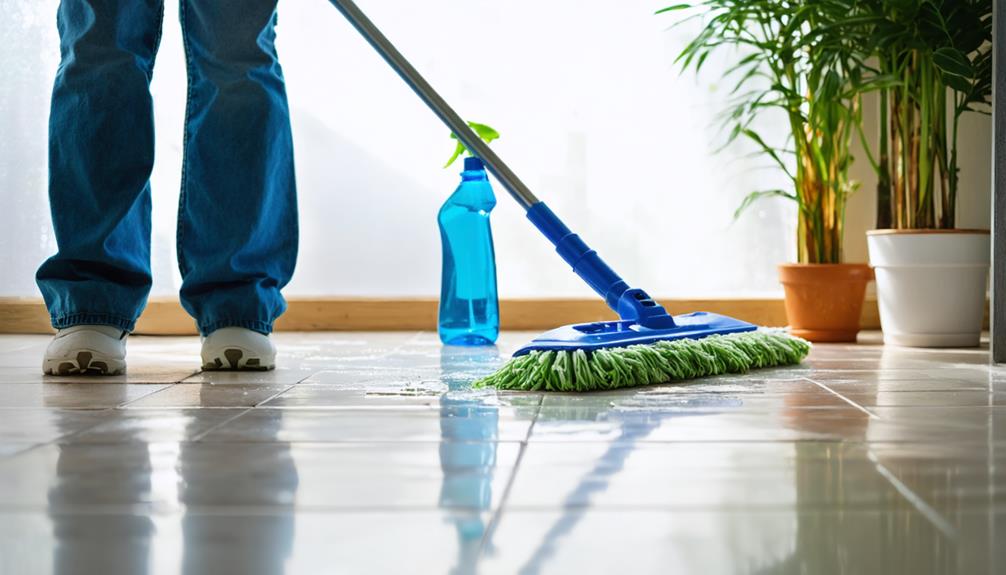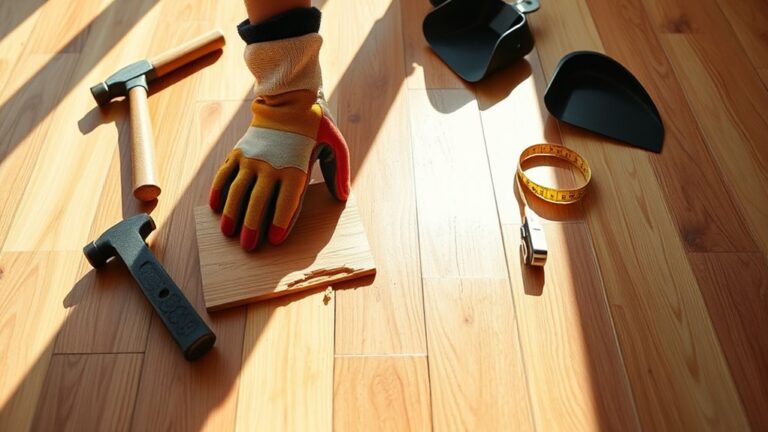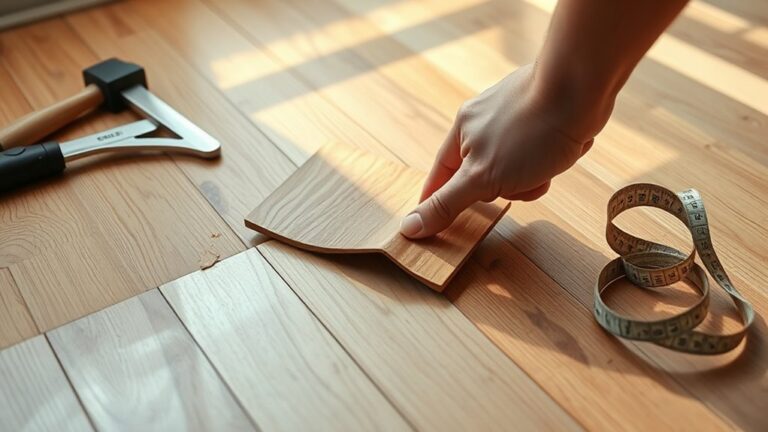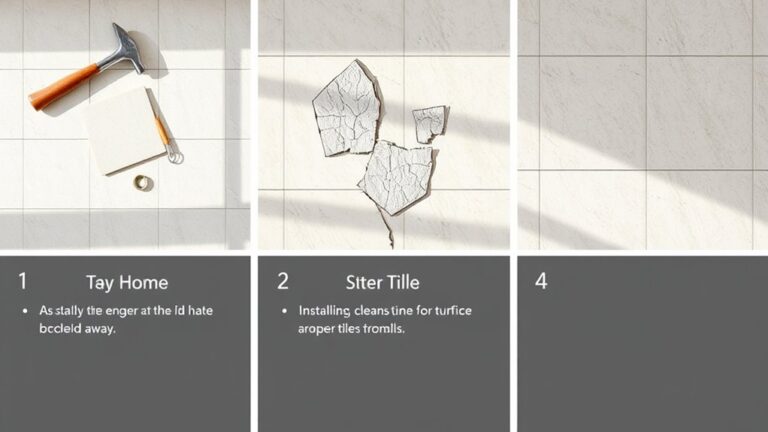To prevent mold and mildew in your tile floors, maintain low moisture levels and adhere to a regular cleaning routine. Guarantee proper ventilation by using exhaust fans and opening windows to reduce humidity. Clean spills immediately and use vinegar or mild detergents weekly to eliminate moisture-wicking residues. Don't forget to seal grout lines annually with a waterproof sealant, which creates a barrier against moisture ingress. Opt for non-porous tiles, like porcelain or ceramic, that resist mold growth. These steps will help maintain a healthier environment, and there's plenty more useful information at your fingertips to enhance your efforts.
Understanding Mold and Mildew
Mold and mildew are two types of fungi that can wreak havoc in your home, especially in areas with tile flooring like bathrooms and kitchens. Mold typically appears as thick, embedded patches in various colors such as black or green. It thrives in warm, damp environments, often where tile and grout retain moisture. On the other hand, mildew manifests as a powdery or fluffy substance, usually white, but can turn black or brown over time. Both fungi thrive in the nooks and crannies of grout lines, making proper upkeep vital.
Understanding the health risks associated with mold and mildew is important. These fungi can trigger respiratory issues and allergic reactions, particularly in those with pre-existing conditions like asthma or weakened immune systems. By recognizing their potential dangers, you can take proactive steps to protect your health and your home.
Tile and grout cleaning should be a regular part of your maintenance routine. Since tile and grout can create ideal conditions for mold and mildew growth, neglecting them can lead to severe consequences. Regular cleaning helps eliminate spores and prevents them from taking hold. Additionally, consider sealing grout lines to reduce moisture retention and guarantee adequate ventilation in your bathrooms and kitchens.
Essential Prevention Techniques
To effectively prevent mold and mildew in tile floors, there are several essential techniques you should implement. These strategies not only help you maintain a clean and healthy environment but also protect your investment in your home.
- Ensure proper ventilation: Keeping airflow in areas with tile flooring can greatly reduce humidity levels that promote mold and mildew growth. Open windows or use fans to circulate air.
- Establish a cleaning routine: Regularly clean tile surfaces using a vinegar solution or mild detergents to remove soap scum and prevent moisture buildup that fosters fungal growth. Make this part of your weekly cleaning tasks.
- Seal grout lines annually: Apply a waterproof sealant to grout to prevent mold. This creates a barrier against moisture penetration, reducing the risk of mold development in those tricky areas.
- Address spills immediately: Promptly clean up any spills or standing water on your tile floors. Quick cleanup prevents moisture from seeping into the grout and underneath tiles, where it can cause considerable issues.
- Utilize dehumidifiers: In moisture-prone areas, a dehumidifier can help maintain ideal humidity levels, further inhibiting the conditions conducive to mold and mildew growth.
Importance of Regular Cleaning
Maintaining a clean environment is essential for preventing mold and mildew, especially in areas with tile flooring. Regular cleaning not only enhances the appearance of your floors but also plays a vital role in mold and mildew prevention. By actively managing dirt, soap residue, and excess water, you create an inhospitable environment for these unwanted pests.
Here's a quick reference table for effective cleaning strategies:
| Cleaning Action | Benefit |
|---|---|
| Weekly cleaning with vinegar | Eliminates moisture and soap scum |
| Scrubbing grout with a toothbrush | Maintains integrity, prevents moisture retention |
| Immediate cleanup of spills | Stops moisture accumulation |
| Using mild detergents | Prevents dirt buildup |
| Consistent routines | Enhances overall hygiene |
Incorporating vinegar or baking soda solutions into your weekly cleaning routine can dramatically reduce the chances of mold growth. Don't forget to scrub your grout lines with a toothbrush; this simple action can prevent mildew by keeping moisture at bay.
Moreover, addressing spills and standing water immediately is essential. Even small amounts of excess water can lead to considerable mold issues if left unattended. Consistency is key—by establishing a regular cleaning routine, you not only enhance the aesthetics of your tile floors but also greatly reduce the risk of mold and mildew development. So, take control of your environment and enjoy a fresher, healthier living space!
Choosing the Right Materials
When you're selecting materials for your tile floors, it is crucial to choose non-porous options like porcelain or ceramic tiles, as they resist moisture absorption. Additionally, using mold-resistant grout and sealants will help keep moisture at bay, reducing the chances of mold and mildew taking hold. By making informed choices about your materials, you can create a more durable and healthier environment in your home.
Mold-Resistant Tile Options
Choosing the right materials for your tile flooring is essential for preventing mold and mildew, guaranteeing a healthier living environment. When you're in the market for tiles, consider the following options that offer mold resistance:
- Non-porous materials: Opt for porcelain or ceramic tiles that resist moisture absorption and minimize mold growth.
- Mold-resistant coating: Look for tiles treated with a mold-resistant coating, providing an extra layer of protection against fungal development.
- Textured surface: Tiles with a textured surface not only enhance slip resistance but also limit moisture accumulation, making them a practical choice.
- Low VOC certifications: Choose tiles with low volatile organic compounds emissions, contributing to better indoor air quality and reducing mold risks.
- Waterproof sealant: Confirm the grout used with your tiles is sealed with a waterproof sealant to prevent moisture infiltration and further protect against mold and mildew.
Non-Porous Material Benefits
The effectiveness of non-porous tile materials, such as porcelain and ceramic, in combatting mold and mildew is clear. These materials resist moisture infiltration, making them far less conducive to mold growth compared to porous alternatives. The smooth surfaces of non-porous tiles allow for easier cleaning, which helps prevent dirt and soap residue accumulation that can attract mold spores.
When installing tile, don't overlook the grout lines. Sealing them with waterproof sealants enhances the non-porous nature of your flooring, providing an extra barrier against moisture that could foster mold growth. Additionally, consider using modern tile adhesives formulated with anti-mold additives; this can further protect against fungal growth beneath the tiles, creating a healthier living space.
Choosing non-porous tile materials for high-moisture areas, like bathrooms and kitchens, considerably reduces the risk of mold and mildew. Not only does this choice promote better indoor air quality, but it also supports overall hygiene in your home. By prioritizing non-porous options, you're taking a proactive step toward maintaining a clean, mold-free environment that allows you the freedom to enjoy your space without worry.
Sealing Grout for Protection
Sealing grout is an essential step in maintaining tile floors, as it effectively creates a barrier against moisture that can lead to mold and mildew growth. Unsealed grout can absorb moisture, making it an ideal breeding ground for mold, which can cause health issues and expensive repairs down the line. To keep your spaces safe and clean, it's important to prioritize sealing grout.
Here are some important tips for sealing grout effectively:
- Choose the right sealant: Modern grout sealants are designed to be waterproof and highly effective in moisture-prone areas, like bathrooms.
- Inspect regularly: Check your grout lines for signs of wear or damage. Regular inspections allow you to catch problems early.
- Seal annually: It's recommended to apply a new layer of protection at least once a year to maintain the effectiveness of the sealant.
- Clean thoroughly: Before sealing, make sure your grout lines are clean and dry. This helps the sealant adhere properly and work its magic.
- Monitor humidity levels: Keep an eye on the humidity in your home. High humidity can lead to quicker degradation of your grout sealant.
Taking these steps not only aids in preventing mold but also enhances the longevity of your tile flooring. By sealing grout effectively, you're not just protecting your floors; you're investing in a cleaner, healthier living space.
Ventilation Strategies
After guaranteeing your grout is sealed, focusing on proper ventilation in your home becomes vital for further mold prevention. One of the most effective ways to combat mold growth is by reducing humidity levels, as this is a primary factor that encourages mold and mildew. Start by utilizing exhaust fans in bathrooms and kitchens. These fans help to pull moist air out of the space, greatly improving airflow and decreasing moisture accumulation.
When you shower, try opening a window or leaving the bathroom door ajar. This simple act enhances ventilation and allows fresh air to flow in, further inhibiting mold growth. Additionally, consider leaving shower doors open after use; this promotes drying and helps maintain low humidity levels.
You might also install timers on bathroom lighting. Keeping these spaces bright for extended periods encourages air circulation, making it less likely for mold to take hold. Regularly inspecting and maintaining your ventilation systems is essential, too. Verify that fans and vents are clean and functioning effectively, as blocked or broken ventilation can lead to increased moisture and mold growth.
Long-Term Maintenance Tips
To maintain a mold-free environment in your tile floors, regular inspections and proactive maintenance are essential. By incorporating a few straightforward practices into your routine, you can greatly reduce the chances of mold and mildew taking hold. Here are some long-term maintenance tips to keep your tile floors pristine:
- Inspect and seal grout lines annually to prevent moisture infiltration.
- Implement a cleaning schedule that includes weekly scrubbing with mold-resistant solutions.
- Use moisture-absorbing products, like silica gel packets, in bathrooms and kitchens.
- Guarantee proper ventilation by using exhaust fans or opening windows in humid areas.
- Replace any damaged tiles promptly to eliminate hidden moisture retention spots.
By following these tips, you're not just cleaning; you're actively preventing mold and mildew from becoming a problem. Keeping a cleaning schedule guarantees that potential spores are eliminated before they settle. Additionally, moisture-absorbing products can be a game changer in confined spaces prone to dampness. Remember, ventilation is key. Allowing fresh air to circulate helps maintain lower humidity levels, reducing moisture retention and consequently the risk of mold growth.
Lastly, don't ignore damaged tiles; they can hide moisture that leads to bigger issues down the line. Taking these steps will empower you to enjoy your tile floors without the worry of mold. With commitment and consistency, preventing mold and mildew can become a seamless part of your lifestyle.
Frequently Asked Questions
How to Prevent Mold on Tiles?
Ever wondered how to keep your tiles pristine and mold-free? Start by implementing effective tile maintenance tips. Use cleaning solutions like vinegar to tackle mold spores directly. Combine this with moisture control methods; guarantee your space is well-ventilated by using exhaust fans or opening windows. Wipe down wet surfaces immediately, and don't forget to seal grout lines annually. These ventilation strategies create a dry environment, making mold growth a distant concern.
Does Sealing Tile Prevent Mold?
Yes, sealing tile does prevent mold. Tile sealants are effective in creating a barrier against moisture, which is a key factor in mold growth. Regular sealing, ideally once a year, is recommended to maintain protection. There are various types of tile sealers, including penetrating and topical sealants, each offering different levels of defense. By choosing the right sealer and following sealing frequency recommendations, you can greatly reduce the chances of mold developing.
How Do You Get Rid of Mold Under Tile Floors?
Imagine uncovering a hidden treasure beneath your tile floor, only to find mold instead. To get rid of it, start with mold identification techniques. Check for leaks or moisture sources. Use effective cleaning solutions like vinegar and baking soda on the affected areas. After cleaning, guarantee thorough drying and consider applying a mold-resistant sealant. Don't forget tile floor maintenance and humidity control methods, like dehumidifiers, to keep your space mold-free.
How to Keep Shower Tile Mold Free?
To keep your shower tile mold-free, focus on effective shower ventilation tips. Open windows or use exhaust fans to reduce humidity. For moisture control, dry tiles after each use with a cloth. Incorporate tile cleaning methods like a weekly vinegar solution to prevent buildup. Don't forget grout maintenance techniques; clean grout regularly and replace old sponges or loofahs. By following these steps, you'll enjoy a fresher, mold-free shower space.




